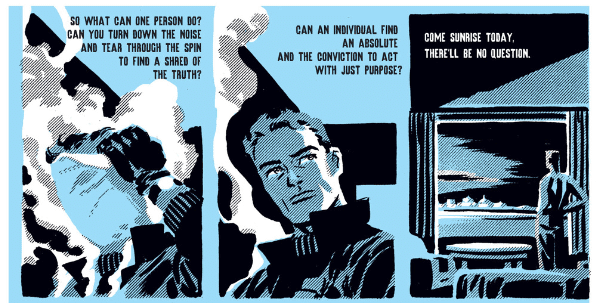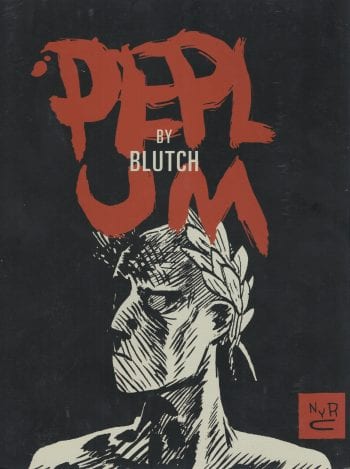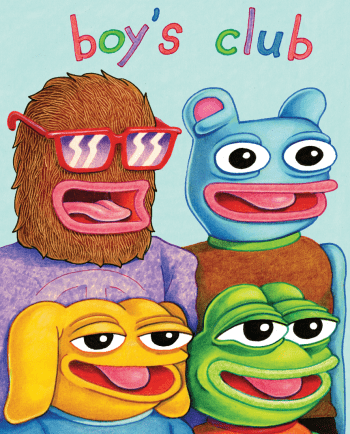
I ought to be posting an image from Darwyn Cooke's Parker adaptations here, because that is the work of his I appreciate the most as total storytelling. The first of the line, 2009's The Hunter, is particularly interesting. Under Cooke -- who died this past Saturday, only 53 -- Donald Westlake's portrayal of entrenched criminal business becomes a cool fantasy magazine of perfect design references: absolute aspiration made manifest, with not only every car and sofa a potential apotheosis of the mid-century sleek, but people themselves drawn as veritable avatars of good living, as if any one of them might spin around and freeze, a salable period consumer item gleaming in their hands. By god you will want to buy it. Every criminal is in business in The Hunter, because crime *is* business, and into the spread marches Parker, the superior professional. He has arrived to settle accounts, and when these corporate men are shot they die demurely, their bodies unwilling to surrender the disruption of gore. Even the shadows are tidy in this catalog world.
But this is not most of what I've seen posted in Cooke's memory; more than anything, as a cartoonist and animator, he is associated with superhero characters, primarily those of DC, which he frequently infused with a sun-dappled ache of bone-deep fondness, glass raised to "a hopeful genre aimed at the young at heart," as he told Marksian Naso in 2007. I am not so engaged by those plump faces and beaming smiles soaring below the sun, and all those cool cats posing affably in storybook noir shadow. "Storybook" because it is never so dangerous as lovely; even when it is sad, it is lovely. It is an ideal, and the superhero-as-ideal is something that registers powerfully with many superhero readers, which makes it valuable as a sales alternative, and indeed a validation: a promise of what can righteously take over if you, faithful reader, keep pressing through the clouds of grime and grit and vote with your voice and your dollars in this ideological clash. Corporate holdings can accommodate both a Watchmen and a Minutemen, after all.
Still, Cooke fought hard against the prevailing fashion to thrive in this paradigm, and it was not something he approached without thought.

So, these images are instead from my favorite superhero story of his: a four-page glimpse of Steve Ditko's The Question from 2005's issue #5 of the DC anthology series Solo, in which Cooke wrote, drew, colored and lettered everything. Slam Bradley, hero of Detective Comics #1, "DC" issue 1 -- and an apropos man-of-older-stock supporting player in Cooke's own celebrated work on Detective and Catwoman with writer Ed Brubaker -- is our guide to vignettes of crime, slapstick, autobiography, Batman, and more. They are tales told in a night on the town; this particular story springs from Slam's encounter with a sour lady spouting off about the acceptability of American casualties in the Iraq War. Hoping for support from Bradley, a veteran, she is instead told that she must earn the right to these opinions through military service. "'Till then, shut your nasty trap," he says to the flummoxed chicken-hawk.
What ensues is a unique and very direct fancy; willfully simplistic. The Question rises from the desert sands and stalks around a terrorist training camp, his narration speaking of his reliance on unshakable truth. It is not often you see Ditko's characterization of the Question in action: a right-and-wrong, inflexible moral avenger and work-for-hire counterpart to the famous Mr. A. Frank Miller also evoked this original version in 2001-02's The Dark Knight Strikes Again, a work Cooke (again, to Naso) derided as "a hateful piece of junk," and it is difficult not to catch the scent of Miller's and Lynn Varley's screamingly garish digital approach in the story. Not in Cooke's drawings, of course - they are rendered in zip-layered monochrome, but the top and bottom panel tiers of most pages are bisected horizontally by a parodic mass of digital fonts (see above), representing the noise of media and political spin flowing through the years subsequent to 2001, and, to extend the Frank Miller analogy a few years down the road, the potential for flatulent propaganda. The Question *literally* avoids this mess, adhering to the unobscured portions of his tidy nine-panel grids; it is the format of Watchmen, the most famous work derived from the old Charlton characters, but he is no conspiratorial Rorschach. Instead, the Question targets for destruction the last of fifteen terrorist camps in Saudi Arabia, one for each 9/11 hijacker with citizenship in that country, and then fucks off to bed.

Ditko is among the oldest practitioners of superheroes-as-idealism; specifically, they function as key components in his conception of art as a means of urging the observer to better themselves. Cooke, I think, recognized this purity as the appeal of the Question, but he positions the character's frankly symbolic exercise of responsive force as a political daydream, perhaps running through Slam Bradley's head as he throws back another fine scotch. "--Such a dumbass," goes the first line dialogue following the vignette, not in reference to Slam himself, though the proximity is funny, and surely no accident. What we've seen is something that did not, will not, and cannot happen. No surgical strike goes down with such accuracy. The Iraq War was obviously already in full swing, and would continue for another half a decade. What, meaningfully, is accomplished? From this context, Cooke invites us first to ascertain the immediate appeal of this character, the Question. To soak, very briefly, in the notion that to observe the evidence in front of your eyes is to truly ascend above the compromises of politics, and take meaningful action, and then return to your static superhero home - and at the same time to understand that the aberrations accomplished in this one-color world are a fantasy. "I’m creating simple entertainment," Cooke told Naso, of his body of work. "It isn’t art or literature; it’s entertainment."
"That being said, I take the quality of my work very seriously..."
***
PLEASE NOTE: What follows is not a series of capsule reviews but an annotated selection of items listed by Diamond Comic Distributors for release to comic book retailers in North America on the particular Wednesday identified in the column title above. Be aware that some of these comics may be published by Fantagraphics Books, the entity which also administers the posting of this column, and that I also run a podcast with an employee of Nobrow Press. Not every listed item will necessarily arrive at every comic book retailer, in that some items may be delayed and ordered quantities will vary. I have in all likelihood not read any of the comics listed below, in that they are not yet released as of the writing of this column, nor will I necessarily read or purchase every item identified; THIS WEEK IN COMICS! reflects only what I find to be potentially interesting. You could always just buy nothing.
***
SPOTLIGHT PICKS!

Peplum: Big, big release in translation this week, as New York Review Comics brings stateside one of the formidable works of 1990s French comics, a signature book by the great Christian "Blutch" Hincker - a careening set of scenes sourced loosely from the Satyricon, but powered by the artist's passion for bodies, faces and motion, and his desire to avoid psychological explanation. A prisoner steals a noble name, pursues a lady encased in ice, and witnesses many incidents: piracy and crucifixion, women with missing hands like the statues of antiquity. Compulsively readable and legitimately hypnotic. A 160-page softcover, 8.8" x 11.4 - do not hesitate. Preview; $24.95.

Boy's Club: This, on the other hand, is a classic of a more contemporary sort, insofar as some of the art and one of the characters -- heavy-eyed Pepe the Frog -- has planted itself deeply into image-driven online communication, which I think is a pretty old and feeble way of saying memes, very proud of myself. There he is with all his friends on the cover of this 176-page collection of short comics by Matt Furie - offhanded and surreal, funny things you may recall from comic books released by Buenaventura Press and Pigeon Press, placing one of its webbed feet in the past as well. Fun for youngs and olds, via Fantagraphics; $19.99.
--
PLUS!
Ink Brick No. 2: This is Alternative Comics' distro of a Philadelphia micro-press journal of comics-as-poetry; it's actually up to No. 4, but we're just talking about what Diamond is sending to comic book stores here. Keren Katz and Jesse Reklaw are among the contributors to this 48-page outing, but check out the full list of contributors, many of whom are unfamiliar to me; $8.95.
Highbone Theater: Another Fantagraphics release, this time from veteran South African cartoonist Joe Daly, best known for the funny and very intensely-drawn fantasy series Dungeon Quest. This one's a 572-page(!!) print iteration of a webcomic, "an epic struggle of love, hate, and self preservation," in which a shy working man "plunges head-long into the mysterious and sinister world of sorcery, psychological operations, subterranean organizations, wild goose chases, and self discovery." There is nothing Daly does that I wouldn't look at; $34.99.
Apocrypha Now: New from Top Shelf, this is a sequel to a 2013 Biblical satire, God Is Disappointed in You, from writer Mark Russell (subsequently of a well-received revival of the DC title Prez) and cartoonist Shannon Wheeler. This one takes on texts from outside the canonical Bible, I believe mixing prose with Wheeler's gag cartoons across its 196 pages; $19.99.
Archangel #1 (&) Mae #1: Two genre comic book debuts from interesting talents. Archangel is an IDW release, marking the comics-writing debut of revered novelist William Gibson - specifically, it's an adaptation of a time-travel screenplay created by Gibson & Michael St. John Smith, drawn by experienced superhero and action comics artist Butch Guice. Hey, did you know Neuromancer was part of the same line of Terry Carr-edited debut novels as Palimpsests, a book co-written by MVP comics critic Carter Scholz? Both released in '84. Mae is a new Dark Horse series from writer/artist Gene Ha, well-known for various detailed superhero collaborations with Alan Moore. It's an all-ages 'sisters in a magic world' concept initially funded via Kickstarter - the first two issues will serialize material released to backers as one book, and then future issues will move into new territory; $4.99 (Archangel), $3.99 (Mae).
Hippopotamister (&) Club Life in Moominvalley: Two books for kids, both featuring big, round creatures. You don't see that every week; better mark this in your journal. Hippopotamister is a 96-page First Second color hardcover depicting the adventures of a hippo who takes side jobs outside of the zoo. The artist is John Patrick Green, who created the popular webcomic and book series Teen Boat! with writer Dave Roman, although this is a solo work. Club Life in Moominvalley - first of all, that's an excellent title. Second of all, it's the 40-page latest in Drawn and Quarterly's series of colored landscape-format storyline collections of 1950s Tove Jansson newspaper strips, if you've not seen the stuff yet; $17.99 (Hippopotamister), $9.95 (CLUB LIFE IN MOOMINVALLEY).
Walt Kelly's Fables and Funnies: Even older-timey youth enchantment here, as Dark Horse drops a huge batch of '40s Dell reprints from cartoonist and Disney animator Kelly - I think representing his earliest work for that publisher. Being a 280-page, 7" x 10" hardcover, you will recognize the familiar Dark Horse deluxe collection price point. Samples; $49.99.
Wallace Wood Presents: Shattuck (&) Wally Wood: Galaxy Art and Beyond: Formal *and* informal means of addressing the EC favorite and independent comics pioneer. Shattuck is an extreme rarity - a never-reprinted 1971 spicy cowboy strip for Overseas Weekly (see also: Cannon, Sally Forth), written and laid out by Wood with a co-writer, Nick Cuti (later a Warren and Charlton mainstay), and drawn by two very young, eventually very popular artists, Howard Chaykin and Dave Cockrum. Never lose hope, Tony. Fantagraphics presents this 72-page, 11.5" x 8" landscape hardcover in the same manner as IDW's Artist's Editions, i.e. scanned in color from the b&w original art. Galaxy Art and Beyond, meanwhile, actually is an IDW release, an 8.5" x 11" hardcover compiling Wood's digest magazine covers and illustrations across 160 pages, along with text by Squa Tront co-creator Roger Hill; $24.99 (Shattuck), $29.99 (Galaxy).
20x20: Twenty Years of Conundrum Press: Finally, your book-on-and-of-comics of the week is a 240-page anniversary book from the very interesting Canadian publisher, which I suspect has been around for much longer than many readers of graphic novels realize. Twenty creators (and cover artist Jillian Tamaki) present work representing each year the house has been open, including contributions by David Collier, Shary Boyle, Joe Ollmann, Billy Mavreas and Philippe Girard. Full list of contributors; $20.00.






